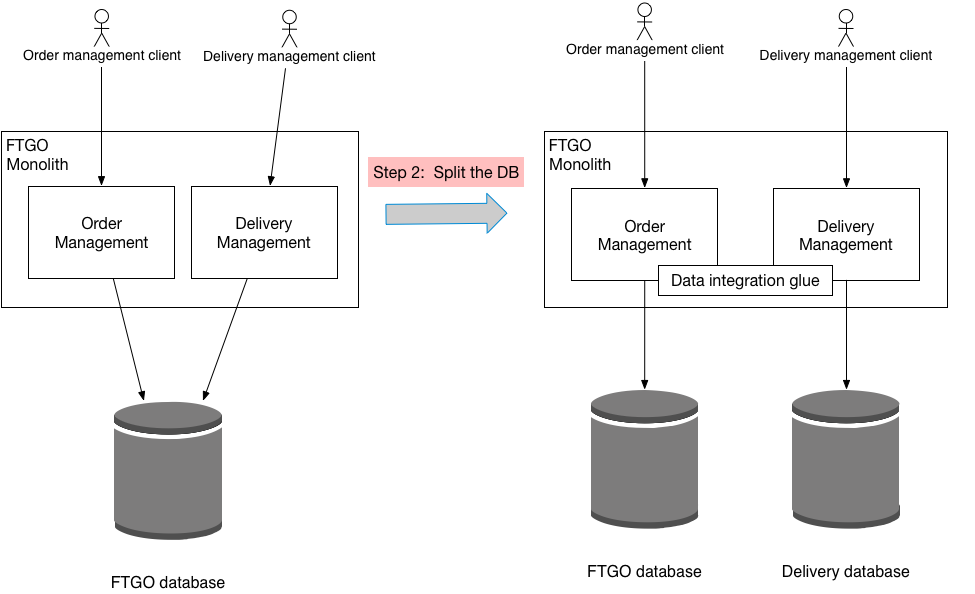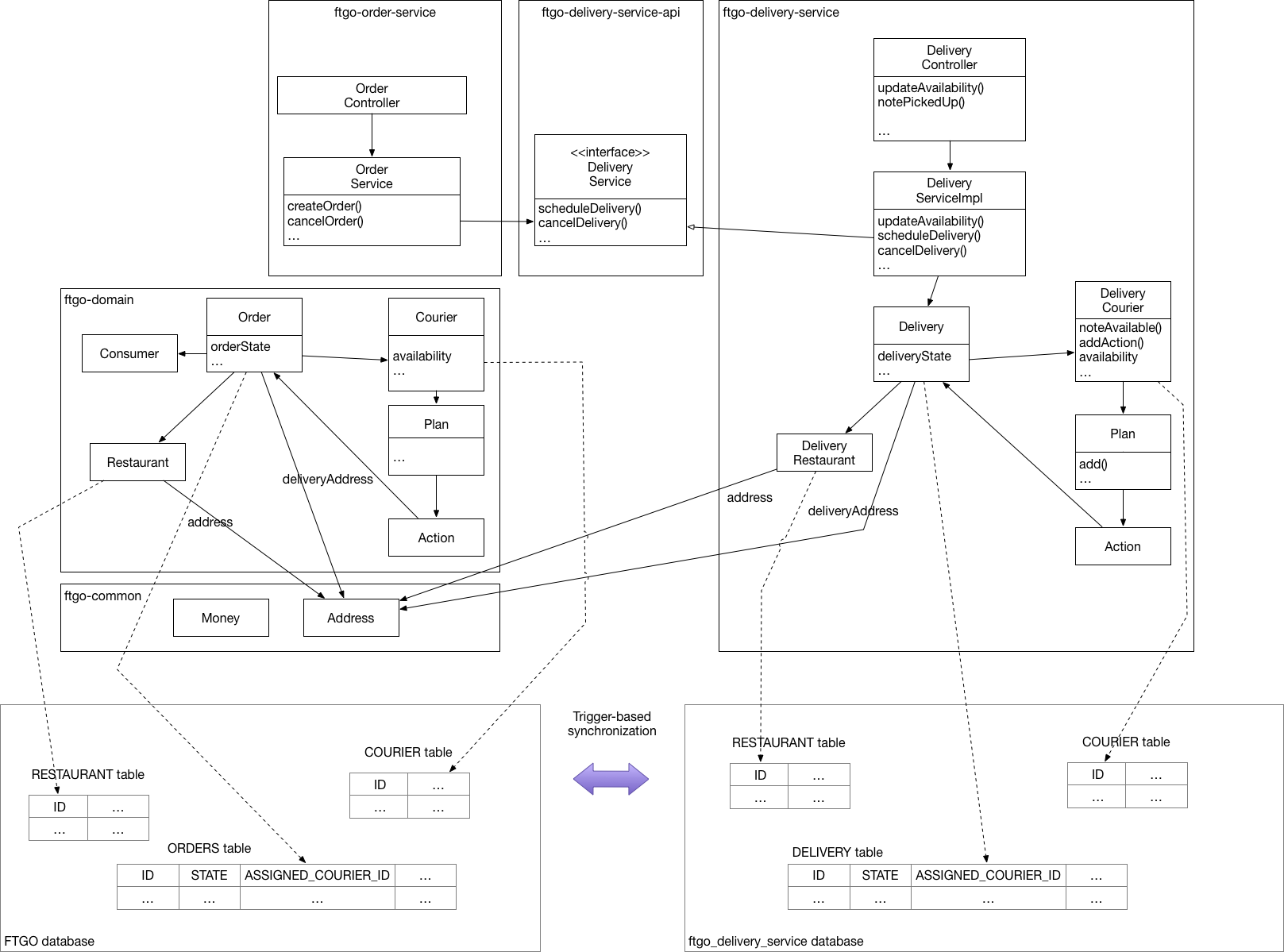Extracting the Delivery Service - Step 2, Split the database
The previous post described the first step of the refactoring process, which consisted of moving the delivery management code into its own ftgo-delivery-service module.
It left the database unchanged and the newly defined JPA @Entity classes in the ftgo-delivery-service module were mapped to the existing database tables.
The Delivery entity was mapped to the Order entity’s ORDERS table.
The second step of the refactoring process splits the database and defines a separate ftgo_delivery_service database for the ftgo-delivery-service module.

The following diagram shows the resulting structure:

The changes are primarily in this Git commit.
About the database migrations
The following Flyway-based schema migrations in ftgo-flyway/src/main/resources/db/migration transform the database:
V2__split_courier.sqlV3__replica_restaurant.sqlV4__extract_into_delivery.sqlV5__FK_constraints.sql
These migrations create the tables in the ftgo_delivery_service database and populate them with data from the monolith’s ftgo database.
They also define triggers, which replicate data between the two databases.
Some triggers replicate updates to data owned by the FTGO monolith, such as Couriers and Restaurants, to ftgo-delivery-service module’s database.
The other triggers replicate changes to data owned by the ftgo-delivery-service module to the monolith’s database in order to make it accessed by the read-only columns described in the previous post.
For example, when the ftgo-delivery-service updates Courier.availability a trigger updates the corresponding column in the ftgo database.
Let’s take a look at each of these schemas.
V2__split_courier.sql
This migration defines the courier and courier_actions tables in the ftgo_delivery_service database and populates them with data from the ftgo.courier and ftgo.courier_actions tables.
It defines several triggers that synchronize data between the two schemas.
The first two replicate changes made to the ftgo_delivery_service database to the ftgo database:
ftgo_delivery_service.courier_availability_updated- replicatesftgo_delivery_service.courier.availabletoftgo.courier.availableftgo_delivery_service.courier_actions_created- replicates inserts intoftgo_delivery_service.courier_actionstoftgo.courier.courier_actions(TODO what about deletes)
The other two triggers replicate changes made to the ftgo database to the ftgo_delivery_service database:
ftgo.courier_created- replicates inserts intoftgo.couriertoftgo_delivery_service.courierftgo.courier_updated- replicates updates offtgo.couriertoftgo_delivery_service.courier
V3__replica_restaurant.sql
This migration defines the restaurant table in the ftgo_delivery_service database and populates it with restaurants from ftgo.restaurant.
It also defines a trigger that replicates inserts into ftgo.restaurant table to the ftgo_delivery_service.restaurant table.
TODO what about UDs
V4__extract_into_delivery.sql
This migration defines the delivery table in the ftgo_delivery_service database and populates it with deliveries from ftgo.delivery.
It also defines a trigger that replicates updates of the ftgo_delivery_service.assigned_courier_id column to the ftgo.delivery table.
V5__FK_constraints.sql
This migration creates foreign key constraints between the newly defined tables.
About the code changes
In addition to the schema changes, there are a few code changes.
First, the JPA entities in the ftgo-delivery-module are mapped to new databases tables.
For example, Delivery is mapped to the delivery table:
@Entity
@Table(name = "delivery", catalog = "ftgo_delivery_service")
@Access(AccessType.FIELD)
@DynamicUpdate
public class Delivery {
...
Second, the DeliveryState enum is simplified since it no longer needs to mirror OrderState.
It now just defines values that correspond to the state of the Delivery.
Third, because Delivery no longer shares a table with Order the DeliveryService.scheduleDelivery() method can no longer load the Delivery.
Instead, it must create the Delivery:
public class DeliveryServiceImpl implements DeliveryService, DeliveryCourierService {
private DeliveryRepository deliveryRepository;
public void scheduleDelivery(LocalDateTime readyBy, Long orderId, long restaurantId, Address deliveryAddress) {
...
delivery = deliveryRepository.save(delivery);
...
}
...
What’s next
- Study the refactored code, which is the
extract-delivery-service-02-split-dbbranch in the main repository. This refactoring is primarily in this commit. - Read chapter 13 of my book Microservices patterns, which covers refactoring to microservices
- Read the next step, which extracts the
Delivery Service. - Talk to me about my microservices consulting and training services


 Premium content now available for paid subscribers at
Premium content now available for paid subscribers at 




